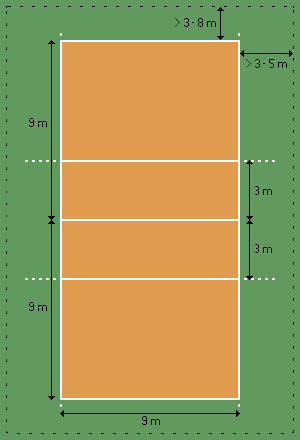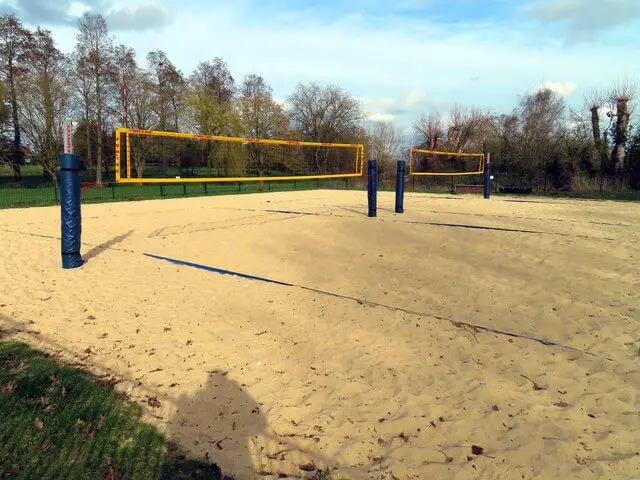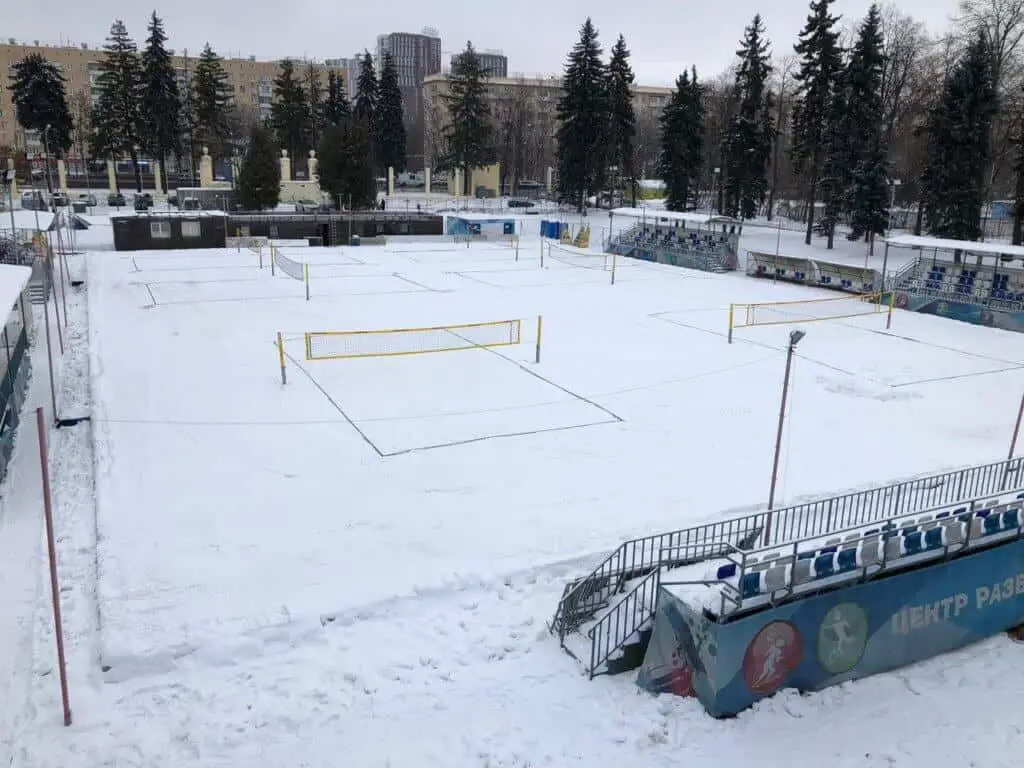If you are new to the world of volleyball you may see the different lines, court sizes and surfaces and just be overwhelmed with exactly what they mean and why the courts are the size they are.
In this article I hope to give you a complete guide on the different volleyball courts, surfaces and sizes for Indoor volleyball, beach volleyball and even the increasingly popular snow volleyball.
Just for clarity all information noted below is as per FIVB guidelines and ruling. Specific countries, regions and governing bodies may have different rulings.
| Volleyball Variation | Volleyball Court Size |
| Indoor Volleyball | 9m (wide) x 18m (long) |
| Beach Volleyball | 8m (wide) x 16m (long) |
| Snow Volleyball | 8m (wide) x 16m (long) |
Table of Contents
Indoor Volleyball Courts
The most popular variation of the sport is Indoor Volleyball.
Indoor Volleyball is a game that is played with 6 players on each side. If you want to learn more about volleyball in particular I would suggest looking through my article here.
As Indoor Volleyball is played with more players the court is slightly larger and contains more lines which help divide the court up.
An Indoor Volleyball court is 18m (long) x 9m (wide).
This makes each teams side 9m x 9m.
The court is marked out using lines that contrast to the floor surfaces,.
There is a perimeter line which runs around the outside of the court.
This consists of two side lines and two baselines.

You will also notice that there is a line that divides each half up. These lines are situated ⅔ of the way into court and rather conveniently is known as the 3m line.
The 3m line is a way of separating players between a front and back row.
Back row players are not allowed to jump and attack the ball from above the height of the net if they leave the floor within the 3m line.
However if they jump from behind this 3m line they are allowed to attack the ball.
This is put in place to prevent teams having 5 different hitting options and 6 people blocking at any one time.
The last line you will notice is the middle line which runs underneath the net.
This line separates your side from your opponents.
The main purpose of this line is to reduce the injuries that may occur from players colliding into each other.
There is a rule in volleyball that if you cross this line with any part of your body, the other team will be awarded the point.
However you can do what is known as saddling the line.
When saddling the line you can nearly your whole foot over the other side of the line however as long as one part of your foot is still touching the line you will not be called for a fault.
Different Court Playing Surfaces
Now it’s true there is a variety of different playing surfaces available when competing in indoor volleyball.
The most commonly used flooring for indoor volleyball is sprung flooring or sometimes known as floating flooring
Sprung flooring was first invented in the 1870’s however it did not rise to popularity in America until the 1920’s
With ever improving materials these are now becoming more viable and sustainable.
The purpose of a sprung floor is to absorb shock whilst offering a nice energy return.
This not only helps players avoid injuries but also offers a bit more bounce and spring in fast pace high velocity movements; such as jumping or changing direction.
Another popular flooring option for indoor volleyball courts is the Vinyl Sports Floor.
This type of flooring is much harder wearing and much more solid underfoot.
This is the flooring you tend to find in most sports halls these days as it is very durable, offers mild shock absorption and is generally a cheaper more sustainable option.
Beach Volleyball Courts
Beach Volleyball is a game in which for the most part consists of two members per team.
As such the court is slightly smaller than an Indoor court.
However just how much smaller it is may surprise you.
A beach Volleyball court is 8m wide x 16m Long.
That’s right it is only 1m thinner and only 2m shorter.
That’s crazy when you think about it.
Just 2 players are expected to cover nearly the same amount of court space as 6 players do indoors.
The court is much simpler design than the indoor court as it simply a rectangle which consists only of base lines and sidelines.

Snow Volleyball Courts
Snow Volleyball is becoming more and more popular and whilst I have never personally played it I can certainly see where the appeal comes from.
I mean who would’ve thought that volleyball would have been played on the snow.
On top of that the places in which these snow tournaments are being played is just incredible.
On top of some beautiful mountains in such scenic places.
Snow volleyball consists of 4 players per team however due to the added difficulty of the cold conditions and the slipping experienced from running round on slushy ice, you may be surprised to hear that the court is the same size as the beach volleyball court.
Yep that’s right.
The snow volleyball court is 8m (wide) x 16m (long)
Again, the court layout is very simple in that it just consists of the outside perimeter lines which simply state whether the ball is in or out.
The court has two sidelines and two backlines.

